Temple Hopping in Cambodia: Beyond Angkor Wat With Your eVisa
Explore Cambodia’s hidden temple gems beyond Angkor Wat with this guide to offbeat sites like Beng Mealea and Preah Vihear. Learn how to plan your journey, what to expect, and how the Cambodia eVisa makes temple hopping easy and unforgettable.
Travelers often associate Cambodia with Angkor Wat, and rightly so. It is one of the most spectacular temples in the world, rich in architectural beauty and full of spiritual significance. However, if you venture off the usual routes you will discover many hidden gems, ruined temples in forest settings, quiet hilltop shrines, and historic sites that rival Angkor in character. With a Cambodia eVisa in hand you can explore these less visited places freely. Here is your more detailed guide to temple exploration beyond Angkor Wat. If you need to travel to Cambodia with an eVisa.
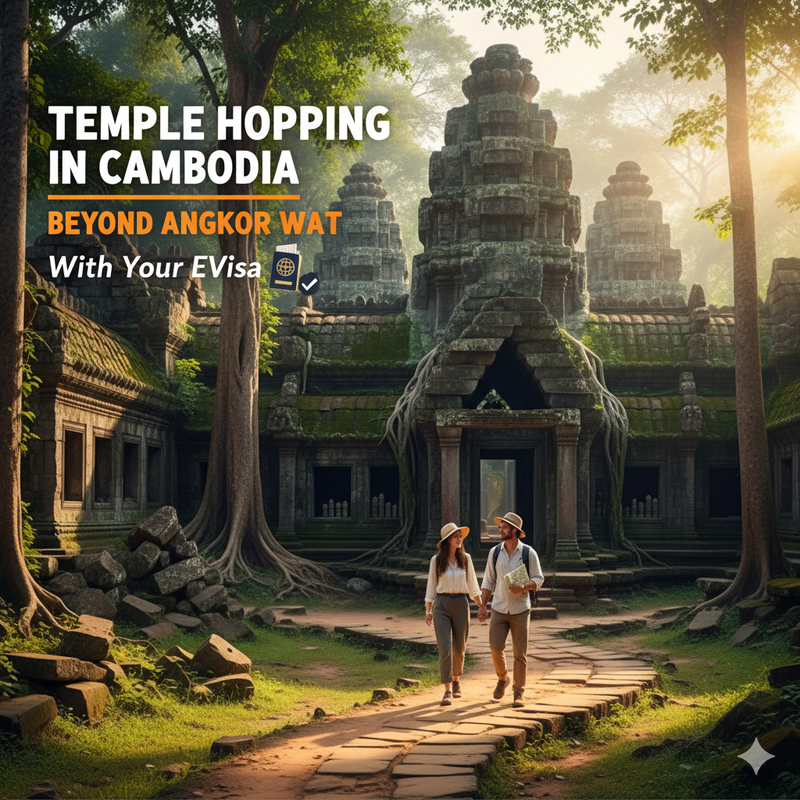
Do I Need a Cambodia eVisa?
Most international visitors need a visa to enter Cambodia. The eVisa system allows you to apply online well before your trip. It reduces waiting at the border. If your purpose is tourism, cultural visits, or temple travel, the eVisa for tourism is usually right for you. You must have a valid passport. The passport should be valid for 6 months from your date of arrival. Be sure your passport has blank pages for immigration stamps.
Types of eVisas and Visa Options for Cambodia
Here are the visa options you should know about when planning temple visits and broader travel in Cambodia:
-
Tourist eVisa (Type T): Planning a trip to Southeast Asia? Explore ancient temples and vibrant culture with ease by applying for a Cambodia Tourist eVisa. This convenient online visa process saves time, letting you focus on the adventure ahead in beautiful, welcoming Cambodia.
-
Business eVisa (Type E): Doing business abroad? Simplify your travel plans with the Cambodia Business e-Visa, designed for professionals seeking smooth entry into Cambodia. Apply online, avoid embassy queues, and focus on your goals. It’s fast, efficient, and perfect for your next international business trip.
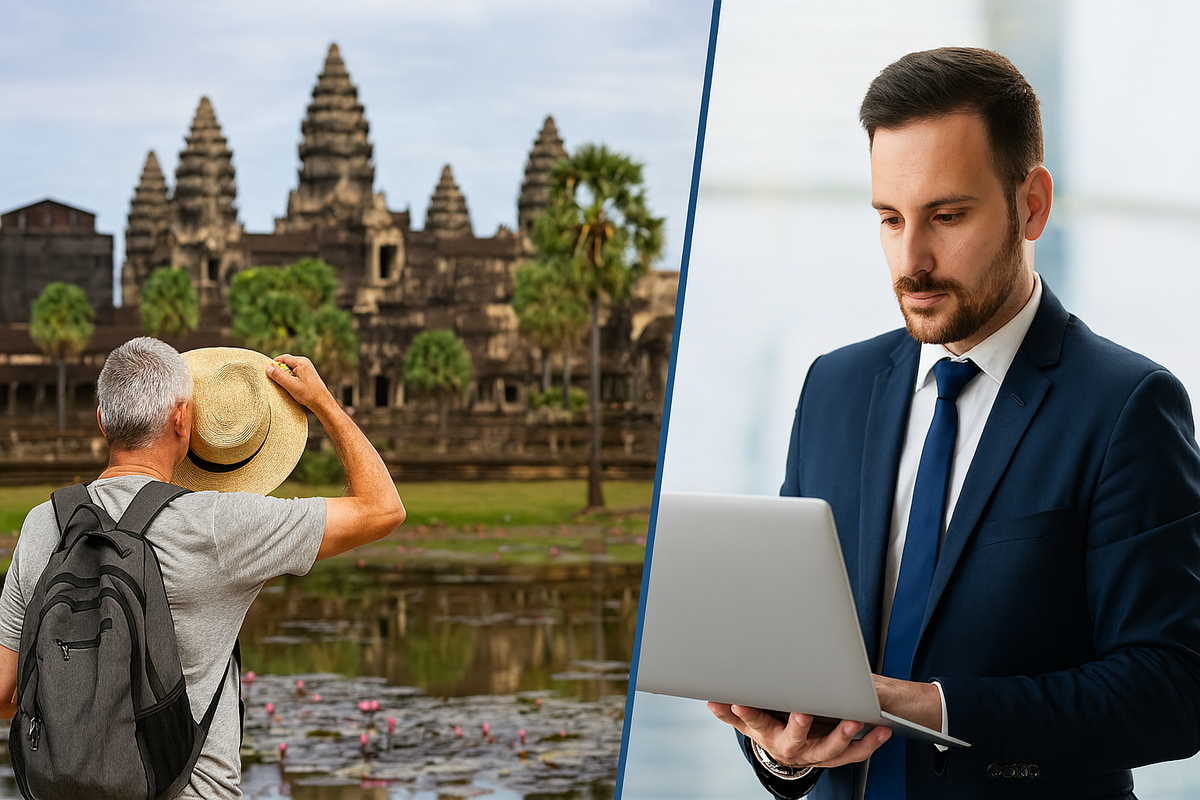
Step-by-Step Guide to Applying for the eVisa
Here is how to apply for the Cambodia eVisa without stress
-
Check that your country is eligible for eVisa and that your arrival point (airport or land border) accepts eVisas. Some offbeat crossings will require a Visa on Arrival or other permit.
-
Gather required documents. Valid passport with 6 months' validity. Passport‑style photo. Scanned copy of your passport data page. Information about where you will stay in Cambodia. Return or onward travel details.
Go to the online Cambodian eVisa portal. Double-check all fields in the form. Make sure your name, passport number, arrival date and other details match your documents.
-
Pay the Cambodia eVisa Fees online. It is usually depends on the type and include processing. Use credit or debit card. Have backup payment means if needed.
-
Wait for approval. Typically one to three business days. Busy season may delay processing. Apply at least one week ahead of your travel date if possible.
-
Print at least two copies of your eVisa PDF. One you keep with you for arrival, another as spare. Also save a digital copy on your phone or cloud.
-
Arrive in Cambodia. Show your printed visa, your passport, hotel information if asked. Be polite and prepared. Some immigration points require additional arrival cards or QR codes.
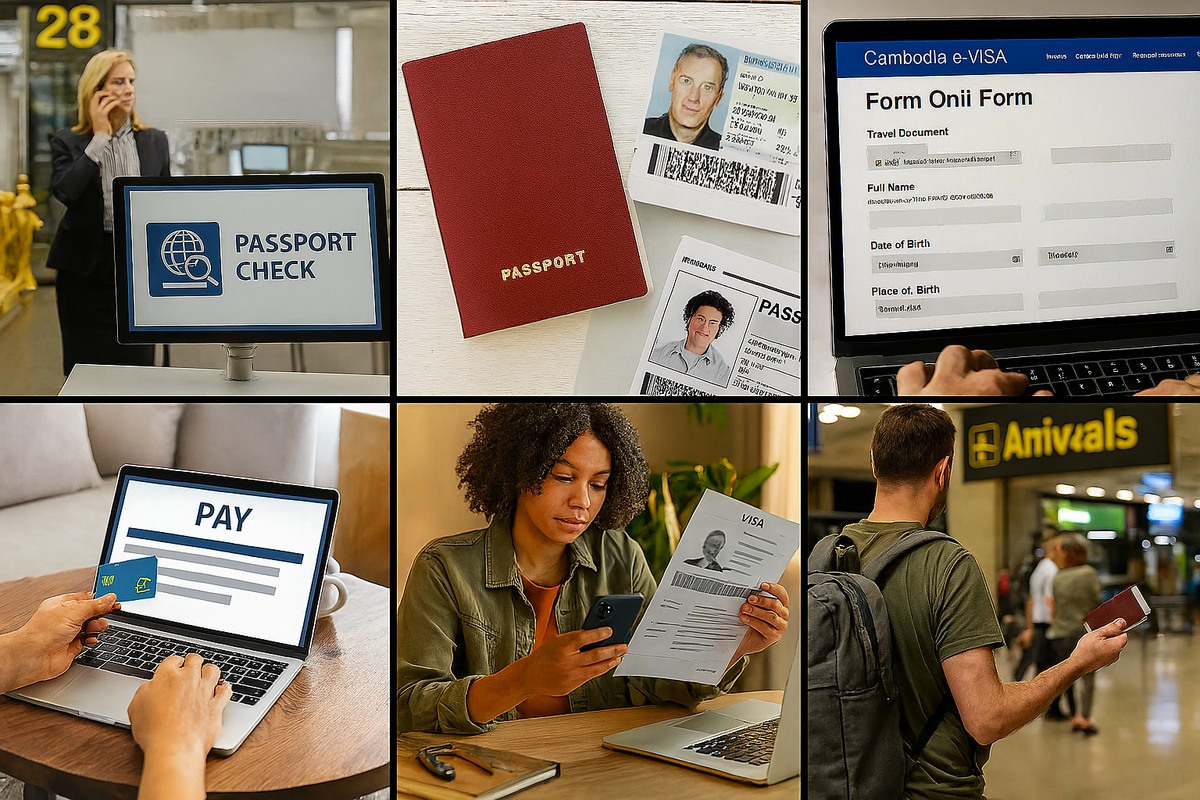
Travel Tips for Temple Hopping in Cambodia
Here are practical suggestions I learned the hard way and you will appreciate later
- Best time to visit is in the dry season between November and February. Rainy season brings green landscapes and dramatic skies but also muddy paths and occasional flooding.
- Start temple tours early in the morning while the air is cooler and crowds are few. Late afternoon light is beautiful too. Midday is hot and busy.
- Bring modest clothing. Shoulders and knees should be covered in most temple sites. A scarf or lightweight layers work well.
- Hire a local guide. Guides add history, legends and meaning to what you see. Without them many stories carved in stone will remain silent.
- Stay hydrated. Carry water, sunscreen and insect repellent. Tropical heat and humid air make these essentials.
- Pack smartly. Comfortable walking shoes are a must. Rain jacket or poncho helps in sudden showers.
- Use both US dollars and local currency (Cambodian Riel). Small shops may prefer small bills. Avoid tired or damaged US bills.
- Negotiate fares clearly in advance when using tuk‑tuks or local transport. Unclear arrangements lead to misunderstandings.
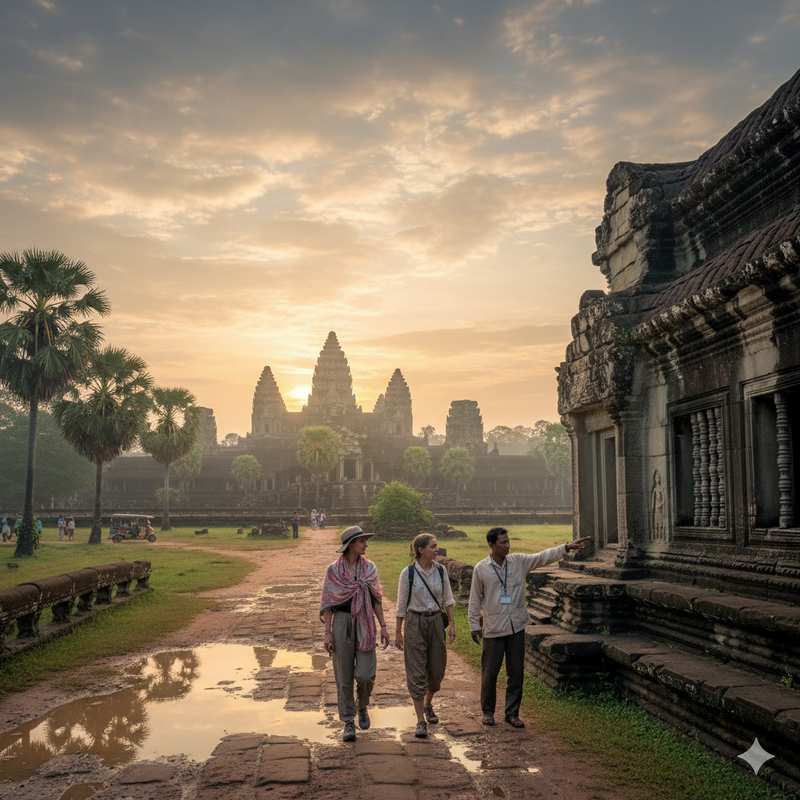
Famous Places and Culinary Delights
These places and foods help you see the fullness of Cambodia beyond its temples.
Famous Sites for Culture and Scenery
- Kulen Mountain: Jungle temples, waterfalls, river carvings known as the Thousand Lingas. A chance to combine both nature and art.
- Beng Mealea: Part jungle, part ruin. Overgrown, dramatic and less crowded. Feels like discovering a lost world.
- Banteay Srei: Small temple made of pink sandstone with detailed carving. Very different feel from the large complexes.
- Preah Vihear Temple: Perched atop cliffs with sweeping views toward the border area. Sense of remoteness makes the visit memorable.
- Tonle Sap Floating Villages: Life on water, fishing boats, stilt houses. Offers insight into daily rhythms of Cambodian communities.
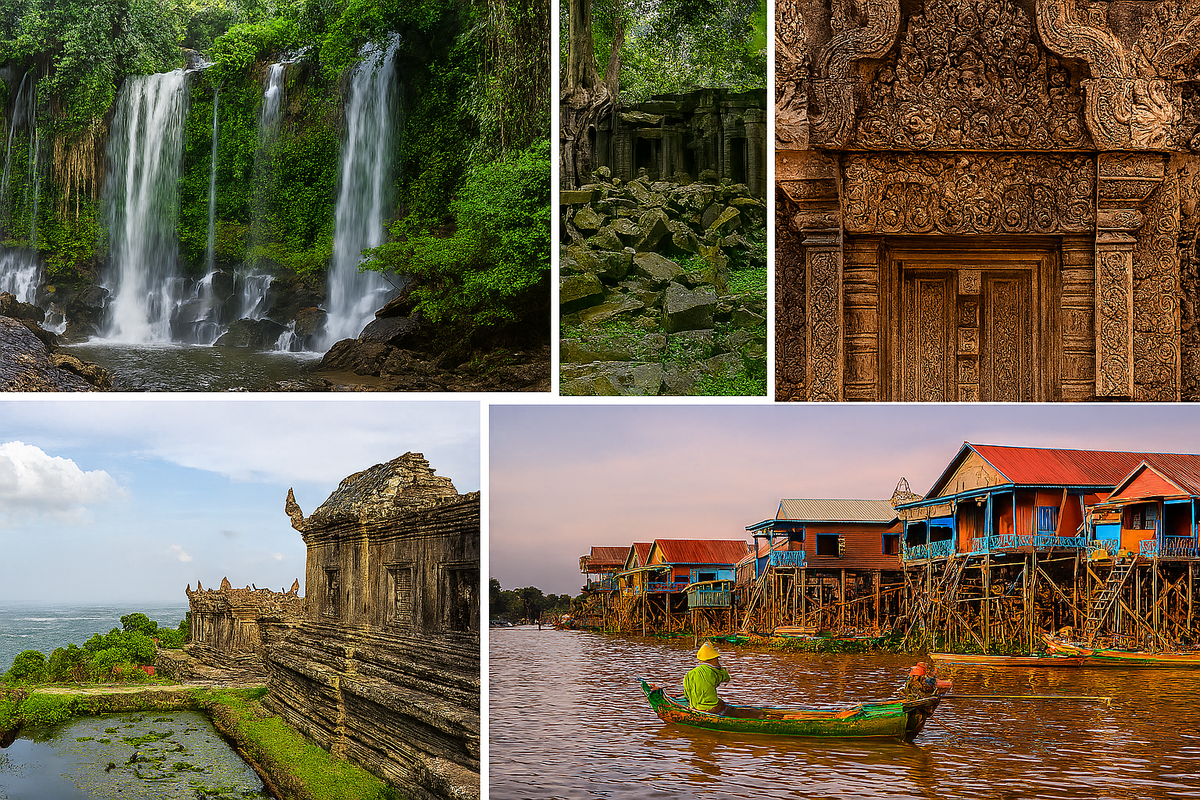
Foods You Should Try
- Fish Amok: Creamy curry with fish, cooked in banana leaf. Aromatic, gentle spices.
- Nom Banh Chok: Fresh rice noodles with green fish curry. Often eaten in the morning by locals.
- Bai Sach Chrouk: Grilled pork over rice, simple tastiness for breakfast or any meal.
- Prahok Ktis: A strong flavored dip made from fermented fish, pork and coconut. It may challenge your palate but it reveals part of local identity.
- Street food vendors: Try fresh fruit, grilled meats, rice snacks. When vendors are busy, turnover is high and food tends to be safer.
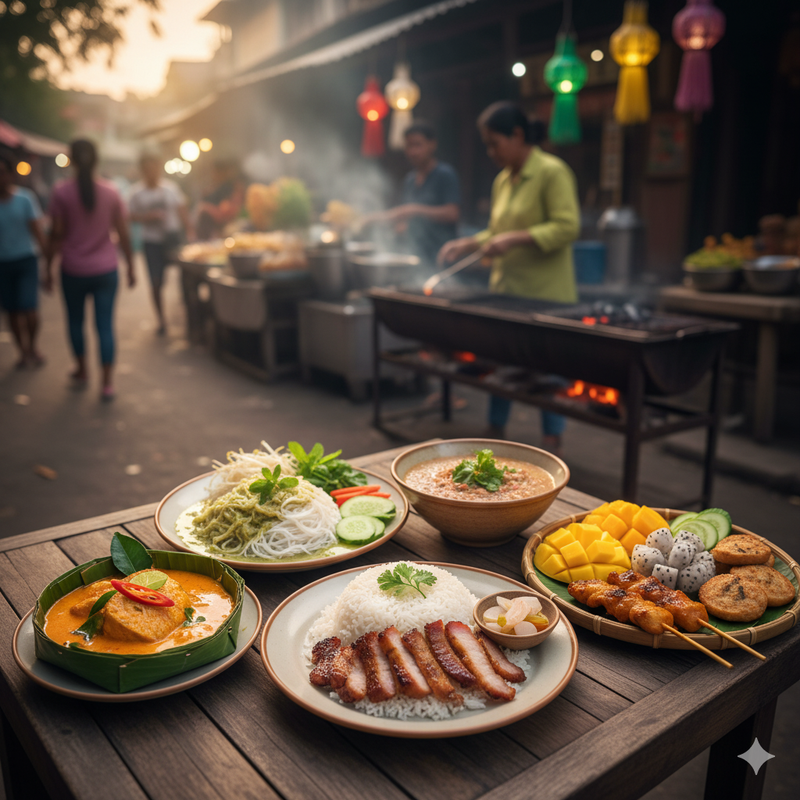
Culture and Traditions
-
Buddhism is central. Temples are living places. Monks in saffron robes; rituals at dawn; respectful attitude is expected. Remove shoes, avoid touching monks, speak softly.
-
Local festivals such as Khmer New Year or Pchum Ben bring communities together. Ceremonies, offerings, local food, colorful processions. If you attend, you feel a pulse of living tradition.
-
Artisan crafts are everywhere. Stone carving, silk weaving, lacquer ware. Visiting local workshops supports communities and gives you meaningful souvenirs.
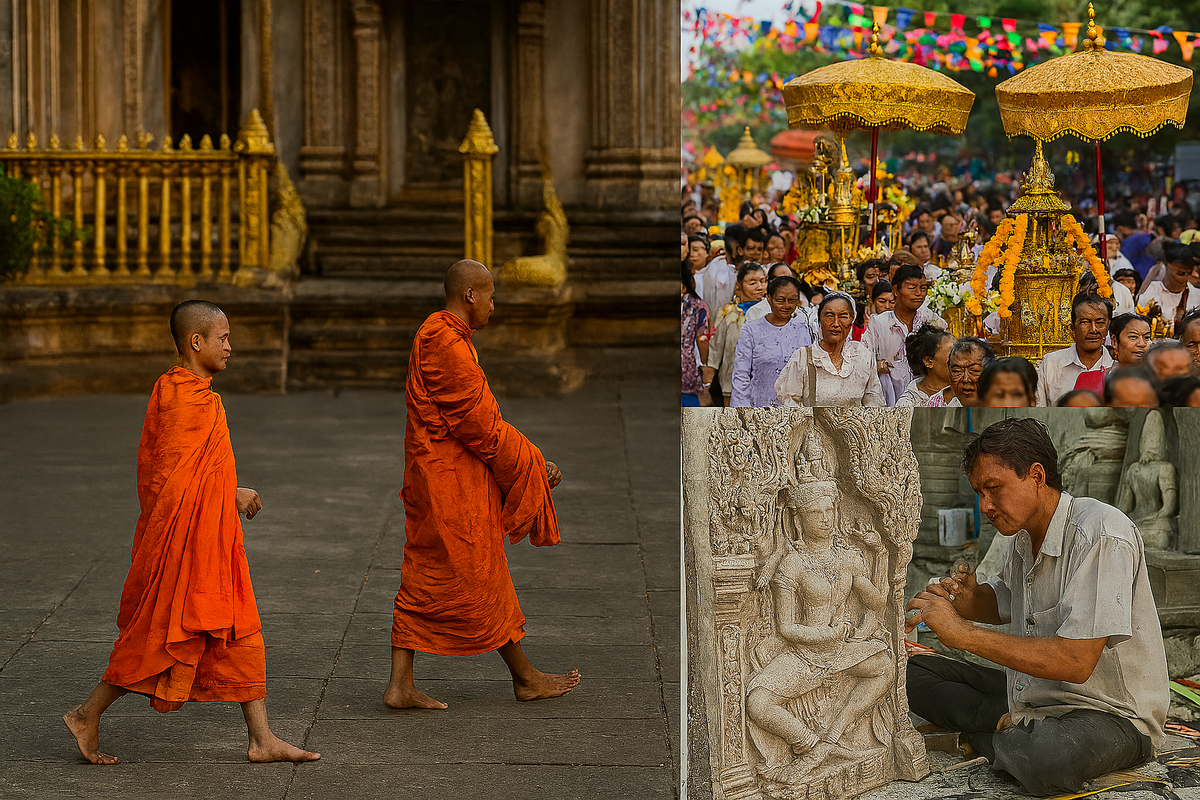
FAQs About the Cambodia eVisa
What is theprocessing time for eVisa? Usually one to 3-5 business days. During peak season or national holidays there may be delays. It is wise to apply at least a week ahead of travel.
Can the eVisa be extended if I decide to stay longer? The standard tourist eVisa cannot be extended. However local immigration services may allow you to change your visa type or apply for other arrangements if you have valid reasons. Local travel‑agencies can help.
Does every border crossing accept eVisas? No. Major airports and many well‑used land borders accept eVisas. Smaller or more remote crossings may not. Always check for your intended entry point before travel.
What if my application is rejected? Common reasons are discrepancies in name or passport number, insufficient passport validity, unclear or missing hotel or travel plans. If rejected you can often correct and reapply. In some cases Visa on Arrival is fallback if available.
Do children need separate eVisas? Yes. Each traveler regardless of age needs individual visa or travel permissions. Information should match the passport.
Final Thoughts and Suggested Itinerary
Stay in Siem Reap for at least three to five days. One day for Angkor main sites. One or two days for offbeat temples. A culture day for markets, floating villages or rural areas adds richness. Reserve time to rest and soak in the atmosphere rather than rushing from ruin to ruin.
Suggested itinerary for five days:
Day 1: Arrive, settle in, try local food, rest. Day 2: Sunrise at Angkor Wat, then Angkor Thom, Ta Prohm, Bayon; sunset at Phnom Bakheng. Day 3: Offbeat temples like Banteay Srei and Beng Mealea. Day 4: Visit Kulen Mountain or Preah Vihear; nature walk or waterfall. Day 5: Culture, markets, possibly floating village; depart or move onward.